Intelligence
 So far, we have considered how we humans think and communicate. But we do so with differing abilities. School boards, courts, and scientists debate the use of tests that assess people’s mental abilities. One of the most heated questions has been whether each of us has some general mental aptitude, or ability to learn, that can be measured and assigned a number.
So far, we have considered how we humans think and communicate. But we do so with differing abilities. School boards, courts, and scientists debate the use of tests that assess people’s mental abilities. One of the most heated questions has been whether each of us has some general mental aptitude, or ability to learn, that can be measured and assigned a number.
In this section, we consider some findings from a century of searching for answers to these questions and more:
- What is intelligence? Is it one general ability, or many different abilities?
- How can we best assess intelligence?
- How do nature (heredity) and nurture (environment) together weave the fabric of intelligence?
What Is Intelligence?
8-11 How do psychologists define intelligence, and what are the arguments for general intelligence (g)?
Intelligence is not a quality like height or weight, which has the same meaning in all generations, worldwide. People assign the term intelligence to the qualities that enable success in their own time and place (Sternberg & Kaufman, 1998). In the Amazon rain forest, intelligence may be understanding the medicinal qualities of local plants. In a North American high school, it may be mastering difficult concepts in tough courses. In both places, intelligence is the ability to learn from experience, solve problems, and use knowledge to adapt to new situations.
236
You probably know some people with talents in science or history, and others gifted in athletics, art, music, or dance. You may also know a terrific artist who is stumped by the simplest math problem, or a brilliant math student with little talent for writing term papers. Are all these people intelligent? Could you rate their intelligence on a single scale? Or would you need several different scales? Simply put: Is intelligence a single overall ability or several specific abilities?
Spearman’s General Intelligence (g)
Charles Spearman (1863–1945) believed we have one general intelligence (often shortened to g) that is at the heart of our smarts, from sailing the sea to sailing through school. People often have special, outstanding abilities, he noted, but those who score high in one area (such as verbal ability) typically score above average in other areas (such as spatial or reasoning ability). Spearman’s belief stemmed in part from his work with factor analysis, a statistical tool that searches for clusters of related items.
In Spearman’s view, mental abilities are much like physical abilities. The ability to run fast is distinct from the eye-hand coordination required to throw a ball on target. Yet there remains some tendency for good things to come packaged together. Running speed and throwing accuracy, for example, often correlate, thanks to general athletic ability. Similarly, intelligence involves distinct abilities, which correlate enough to define a small general intelligence factor.
Other psychologists have questioned the extent of the g factor, or common skill set. Howard Gardner and Robert Sternberg believe there are several different kinds of intelligence.
Theories of Multiple Intelligences
8-12 What are two theories of multiple intelligences, and what criticisms have they faced?

GARDNER’S EIGHT INTELLIGENCES Howard Gardner (1983, 2006, 2011; Davis et al., 2011) views intelligence as multiple abilities that come in different packages. He asks us to consider people with brain damage, who may lose one ability while others remain intact. He sees other evidence of multiple intelligences in people with savant syndrome. Despite their island of brilliance (their special talent), these people often score low on intelligence tests and may have limited or no language ability (Treffert & Wallace, 2002). Some can render incredible art work or musical performances. Others can compute numbers as quickly and accurately as an electronic calculator, or identify almost instantly the day of the week that matches any given date in history (Miller, 1999).
“You have to be careful, if you’re good at something, to make sure you don’t think you’re good at other things that you aren’t necessarily so good at…. Because I’ve been very successful at [software development] people come in and expect that I have wisdom about topics that I don’t.”
Bill Gates, 1998
Four in five people with savant syndrome are males. Many also have autism spectrum disorder (ASD) (see Chapter 3). The late memory whiz Kim Peek (who did not have ASD) was the inspiration for the movie Rain Man. In 8 to 10 seconds, Peek could read and remember a page. During his lifetime, he memorized 9000 books, including Shakespeare’s plays and the Bible. He learned maps from the front of phone books, and he could provide GPS-like travel directions within any major U.S. city. Yet he could not button his clothes, and he had little capacity for abstract concepts. Asked by his father at a restaurant to “lower your voice,” he slid lower in his chair to lower his voice box. Asked for Lincoln’s Gettysburg Address, he responded, “227 North West Front Street. But he only stayed there one night—he gave the speech the next day” (Treffert & Christensen, 2005).
Gardner has identified a total of eight relatively independent intelligences, including the verbal and mathematical aptitudes assessed by standard tests (FIGURE 8.9). Thus, the computer programmer, the poet, the street-smart adolescent who becomes a crafty executive, and the basketball team’s play-making point guard exhibit different kinds of intelligence (Gardner, 1998). To Gardner, a general intelligence score is like the overall rating of a city—which tells you something but doesn’t give you much specific information about the city’s schools, streets, or nightlife.

237
STERNBERG’S THREE INTELLIGENCES Robert Sternberg (1985, 1999, 2003) agrees with Gardner that there is more to real-world success than traditional intelligence and that we have multiple intelligences. But his triarchic theory proposes three, not eight, intelligences:
- Analytical intelligence (school smarts: traditional academic problem solving)
- Creative intelligence (trailblazing smarts: the ability to generate novel ideas)
- Practical intelligence (street smarts: skill at handling everyday tasks)
Gardner and Sternberg differ in some areas, but they agree on two important points: Multiple abilities can contribute to life success, and diverse gifts add both variety to life and challenges for education. Under their influence, many teachers have been trained to appreciate such variety and to apply multiple intelligence theories in their classrooms.
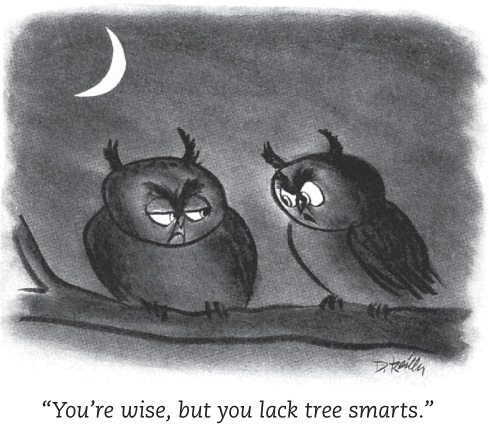
CRITICISMS OF MULTIPLE INTELLIGENCE THEORIES Wouldn’t it be wonderful if the world were so just that a weakness in one area would be balanced by genius in some other area? Alas, say critics, the world is not just (Ferguson, 2009; Scarr, 1989). Recent research, using factor analysis, has confirmed that there is a general intelligence factor (Johnson et al., 2008). g matters. It predicts performance on various complex tasks and in various jobs (Arneson et al., 2011; Gottfredson, 2002a,b, 2003a,b). Youths’ intelligence test scores predict their income decades later (Zagorsky, 2007).
238
But we do well to remember that the recipe for success is not simple. As in so many realms of life, success has two ingredients: can do (ability) and will do (motivation) (Lubinski, 2009). More than 300 studies of college and university students confirm the point. Study habits, study skills, and a “hungry (curious) mind” are important for academic success (Credé & Kuncel, 2008; von Stumm et al., 2011). High intelligence may get you into a profession (via the schools and training programs that open doors). Grit—your motivation and drive—will make you successful once you’re there.
Highly successful people tend to be conscientious, well connected, and doggedly energetic. These qualities often translate into dedicated hard work. Researchers report a 10-year rule: Expert performers—in chess, dancing, sports, computer programming, music, and medicine—have all spent about a decade in intense, daily practice (Ericsson, 2002, 2007; Simon & Chase, 1973). Becoming a chess master requires a certain cognitive ability. But it also requires practice—about 11,000 hours on average, and at least 3000 hours (Campitelli & Gobet, 2011). (For more on how self-disciplined grit feeds success, see Appendix B.) 
RETRIEVE + REMEMBER
Question 8.9
How does the existence of savant syndrome support Gardner’s theory of multiple intelligences?
People with savant syndrome have limited mental ability overall but possess one or more exceptional skills. According to Howard Gardner, this suggests that our abilities come in separate packages rather than being fully expressed by one general intelligence that covers all our talents.
Question 8.10
How do Gardner’s and Sternberg’s theories of multiple intelligences differ?
Gardner sees intelligence as eight relatively independent abilities. Sternberg agrees with Gardner that there is more to real-world success than traditional understandings of intelligence. However, he thinks that there are just three kinds of intelligence, not eight.
Emotional Intelligence
8-13 What four abilities make up emotional intelligence?
Some psychologists have further explored our nonacademic social intelligence—the know-how involved in understanding social situations and managing ourselves successfully (Cantor & Kihlstrom, 1987). Psychologist Edward Thorndike first proposed the concept in 1920, noting that “the best mechanic in a factory may fail as a foreman for lack of social intelligence” (Goleman, 2006, p. 83).
Research has focused on a critical part of social intelligence, emotional intelligence, with its four abilities (Mayer et al., 2002, 2008).
- Perceiving emotions (recognizing them in faces, music, and stories)
- Understanding emotions (predicting them and how they may change and blend)
- Managing emotions (knowing how to express them in varied situations)
- Using emotions to enable adaptive or creative thinking
Emotionally intelligent people are both socially aware and self-aware. Those who score high on managing emotions enjoy higher-quality interactions with friends (Lopes et al., 2004). They avoid being hijacked by overwhelming depression, anxiety, or anger. They can read others’ emotions and know what to say to soothe a grieving friend, encourage a workmate, and manage a conflict.
These emotionally intelligent people also perform modestly better on the job (O’Boyle et al., 2011). On and off the job, they can delay gratification in favor of long-range rewards. Simply said, they are emotionally smart. Thus, they tend to succeed in career, marriage, and parenting situations where academically smarter (but emotionally less intelligent) people often fail (Ciarrochi et al., 2006).
* * *
For a summary of Spearman’s, Gardner’s, and Sternberg’s theories, see TABLE 8.3.
239
Assessing Intelligence
An intelligence test assesses a person’s mental aptitudes and compares them with those of others, using numerical scores. So, how do psychologists design these tests, and why should we believe in the results?
What Do Intelligence Tests Test?
8-14 When and why were intelligence tests created, and how do today’s tests differ from early intelligence tests?
Barely more than a century ago, psychologists began designing tests to assess people’s abilities. Some measured aptitude (ability to learn). Others assessed achievement (what people have already learned).

ALFRED BINET: PREDICTING SCHOOL ACHIEVEMENT Modern intelligence testing traces its birth to early twentieth-century France, where a new law required all children to attend school. French officials knew that some children, including many newcomers to Paris, would need special classes. But how could the schools make fair judgments about children’s learning potential? Teachers might assess children who had little prior education as slow learners. Or they might sort children into classes on the basis of their social backgrounds. France’s minister of public education took action to minimize such bias in 1904. He gave Alfred Binet and others, including Théodore Simon, the task of studying this problem.
Binet and Simon began by assuming that all children follow the same course of intellectual development but that some develop more rapidly. A “dull” child should therefore score much like a typical younger child, and a “bright” child like a typical older child. Binet and Simon now had a clear goal. They would measure each child’s mental age, the level of performance typically associated with a certain chronological age. The average 8-year-old, for example, has a mental age of 8. An 8-year-old with a below-average mental age (perhaps performing at the level of a typical 6-year-old) would struggle with schoolwork considered normal for 8-year-olds.
Binet and Simon tested a variety of reasoning and problem-solving questions on Binet’s two daughters, and then on “bright” and “backward” Parisian schoolchildren. The items they developed predicted how well French children would handle their schoolwork.
LEWIS TERMAN: THE INNATE IQ Soon after Binet’s death in 1911, others adapted his tests for wider use. One of them was Lewis Terman (1877–1956), a Stanford University professor. Terman found that the Paris-developed questions and age norms worked poorly with California schoolchildren. He adapted some items, added others, and established new standards for various ages. He also extended the upper end of the test’s range from teenagers to “superior adults.” He gave his revision the name it still has today—the Stanford-Binet. For Terman, intelligence tests revealed the intelligence with which a person was born.
German psychologist William Stern’s contribution to intelligence testing was the famous term intelligence quotient, or IQ. The IQ was simply a person’s mental age divided by chronological age (age in years) and multiplied by 100 to get rid of the decimal point.
Thus, an average child, whose mental age (8) and chronological age (8) are the same, has an IQ of 100. But an 8-year-old who answers questions at the level of a typical 10-year-old has an IQ of 125:

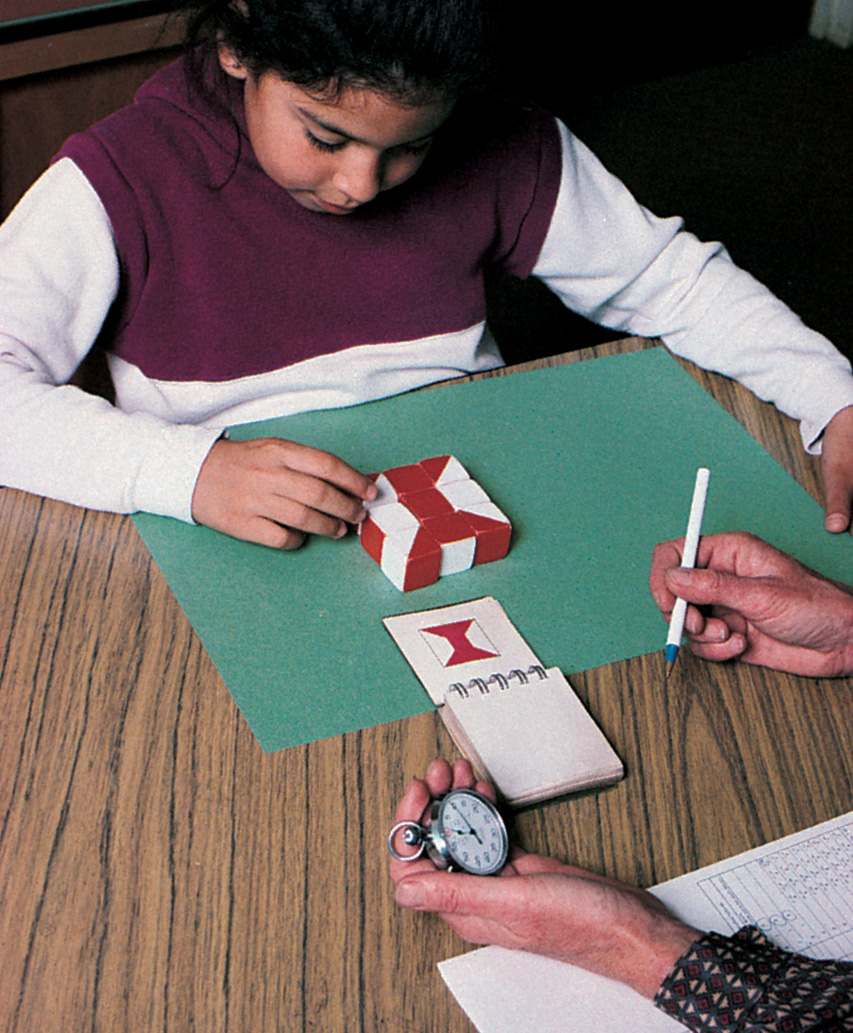
The original IQ formula worked fairly well for children but not for adults. (Should a 40-year-old who does as well on the test as an average 20-year-old be assigned an IQ of only 50?) Most current intelligence tests, including the Stanford-Binet, no longer compute an IQ (though the term IQ still lingers in everyday vocabulary as short for “intelligence test score”). Instead, they represent the test-taker’s performance relative to the average performance of others the same age. This average performance is arbitrarily assigned a score of 100. Most people—68 percent of those taking an intelligence test—fall between 85 and 115. (We’ll return to these figures later in this chapter, in the discussion of the normal curve.)
240
DAVID WECHSLER: SEPARATE SCORES FOR SEPARATE SKILLS Psychologist David Wechsler created what is now the most widely used intelligence test, the Wechsler Adult Intelligence Scale (WAIS). There is a version for school-age children (the Wechsler Intelligence Scale for Children [WISC]), and another for preschool children. The WAIS (2008 edition) consists of 15 subtests, broken into verbal and performance areas, including these:
- Similarities—Considering the commonality of two objects or concepts, such as “In what way are wool and cotton alike?”
- Vocabulary—Naming pictured objects, or defining words (“What is a guitar?”)
- Block design—Visual abstract processing, such as “Using the four blocks, make one just like this.”
- Letter-number sequencing—On hearing a series of numbers and letters, repeat the numbers in ascending order, and then the letters in alphabetical order: “R-2-C-1-M-3.”
The WAIS yields both an overall intelligence score and separate scores for verbal comprehension, perceptual organization, working memory, and processing speed. Striking differences among these scores can provide clues to strengths or weaknesses. For example, a person who scores low on verbal comprehension but has high scores on other subtests may have a reading or language disability. Other comparisons can help health care workers design a therapy plan for a stroke patient. In such ways, tests help realize Binet’s aim: to identify opportunities for improvement and strengths that teachers and others can build upon. 
RETRIEVE + REMEMBER
Question 8.11
What did Binet hope to achieve by establishing a child’s mental age?
Binet hoped that the child’s mental age (the age that typically corresponds to the child’s level of performance) would help identify appropriate school placements with children of similar abilities.
Question 8.12
An employer with a pool of applicants for a single available position is interested in testing each applicant’s potential. To help her decide whom she should hire, she should use an ____________ (achievement/aptitude) test. That same employer wishing to test the effectiveness of a new, on-the-job training program would be wise to use an ____________ (achievement/aptitude) test.
aptitude; achievement
Question 8.13
What is the IQ of a 4-year-old with a mental age of 5?
125 (5 ÷ 4 × 100 = 125)
Three Tests of a “Good” Test
8-15 What is a normal curve, and what does it mean to say that a test has been standardized and is reliable and valid?
To be widely accepted, a psychological test must be standardized, reliable, and valid. The Stanford-Binet and Wechsler tests meet these requirements.
WAS THE TEST STANDARDIZED? The number of questions you answer correctly on an intelligence test would tell you almost nothing about how well you performed. For a score to be meaningful, you need some basis for comparison. That’s why test-makers give new tests to a representative sample of people. The scores from this pretested group become the basis for future comparisons. If you later take the test following the same procedures, your score will be meaningful when compared with others. This process is called standardization.
One way to compare scores is to graph them. No matter what trait we measure—height, weight, or mental aptitude—people’s scores tend to form a bell-shaped pattern called the normal curve. The highest point of a symmetrical bell curve is the average score. Moving out from the average, toward either extreme, we find fewer and fewer people.
On an intelligence test, the average score has a value of 100 (FIGURE 8.10). For the Stanford-Binet and the Wechsler tests, your score would indicate whether your performance fell above or below that average. A score of 130, for example, would indicate that only 2 percent of all test-takers had scores higher than yours. About 95 percent of all people score within 30 points above or 30 points below 100.
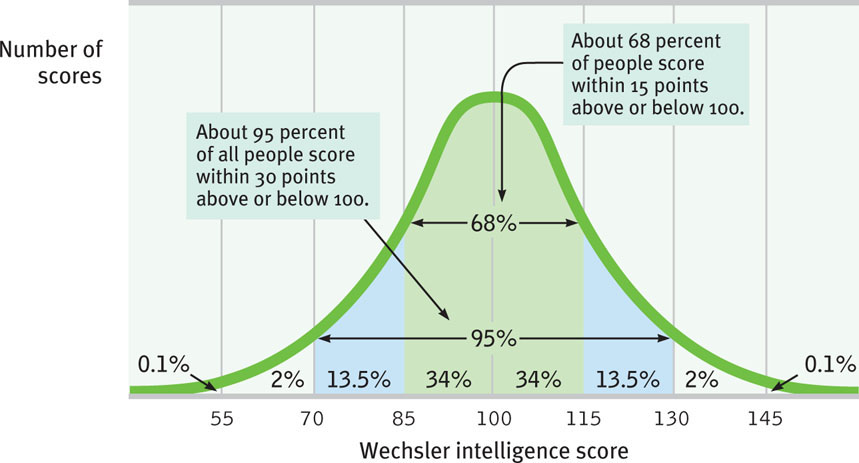
IS THE TEST RELIABLE? Knowing how your score compares with those in the standardization group still won’t tell you much unless the test has reliability. A reliable test gives consistent scores, no matter who takes the test or when they take it. To check a test’s reliability, researchers test many people many times. They may retest people using the same test, or they may split the test in half and see whether odd-question scores and even-question scores agree. If the two sets of scores generally agree, the test is reliable. The tests we have considered so far—the Stanford-Binet, the WAIS, and the WISC—all are very reliable. When retested, people’s scores generally match their first score closely—even over a lifetime (Deary et al., 2004, 2009).
241
IS THE TEST VALID? A valid test measures or predicts what it promises. A test can be reliable but not valid. Imagine buying a tape measure with faulty markings. If you use it to measure people’s heights, your results will be very reliable. No matter how many times you measure, people’s heights will be the same. But your faulty results will not be valid.
Valid tests have content validity when they measure what they are supposed to measure. The road test for a driver’s license has content validity because it samples the tasks a driver routinely faces. A course exam has content validity if it tests what you learned in the course. But we also expect intelligence tests to have predictive validity. Intelligence tests should predict future performance, and to some extent, they do. (See Close-Up: Extremes of Intelligence.) Past grades—which reflect both aptitude and motivation—are better predictors of future achievements. 
RETRIEVE + REMEMBER
Question 8.14
What are the three requirements that a psychological test must meet in order to be widely accepted? Explain.
A psychological test must be standardized (pretested on a similar group of people), reliable (yielding consistent results), and valid (measuring or predicting what it is supposed to measure or predict).
The Nature and Nurture of Intelligence
8-17 How is intelligence influenced by nature and nurture? What does it mean when we say that a trait is heritable?
Intelligence runs in families. But why? Are our intellectual abilities mostly inherited? Or are they molded by our environment? Few issues in psychology arouse so much passion. Let’s look at some of the evidence.
What Do Twin and Adoption Studies Tell Us?
Does sharing the same genes also mean sharing the same mental abilities? As you can see from FIGURE 8.11, which summarizes many studies, the answer is Yes.

Identical twins who grow up together have intelligence test scores nearly as similar as those of the same person taking the same test twice (Haworth et al., 2009; Lykken, 1999). Identical twins are also very similar in specific talents, such as music, math, and sports (Vinkhuyzen et al., 2009). (Fraternal twins, who share only about half their genes, are much less similar.) Even when identical twins are adopted by two different families, their intelligence test scores are nearly the same.
There is, however, no known “genius” gene. Many, many genes contribute to intelligence, and each of them accounts for much less than 1 percent of our differences (Butcher et al., 2008; Davies et al., 2011). Intelligence is thus like height (Johnson, 2010). Working together, 54 specific gene variations account for only 5 percent of our individual height differences.
So genes matter, but environment matters too. Fraternal twins are genetically no more alike than any other siblings. But they usually share an environment and, because they are the same age, are often treated more alike. They also tend to score more alike than other siblings. Moreover, adoption of mistreated or neglected children enhances intelligence scores (van IJzendoorn & Juffer, 2005, 2006). So does adoption from poverty into middle-class homes (Nisbett et al., 2012).
242
C L O S E - U P
Extremes of Intelligence
8-16 What are the traits of those at the low and high intelligence extremes?
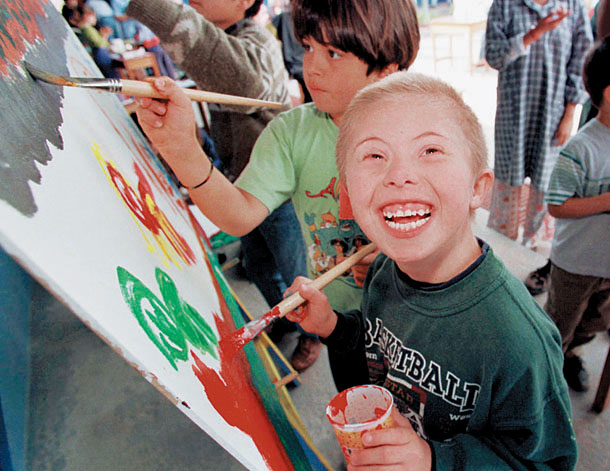
One way to glimpse the validity and significance of any test is to compare people who score at the two extremes of the normal curve. The two groups should differ noticeably, and they do.
The Low Extreme
At one extreme of the intelligence test normal curve are those with unusually low scores. To be given a diagnosis of intellectual disability, a person must have both
- an intelligence score of 70 or below.
- difficulty adapting to life demands.
Intellectual disability is a developmental condition that exists before age 18, sometimes with a known physical cause. Down syndrome, for example, is a disorder of varying intellectual and physical severity caused by an extra copy of chromosome 21.
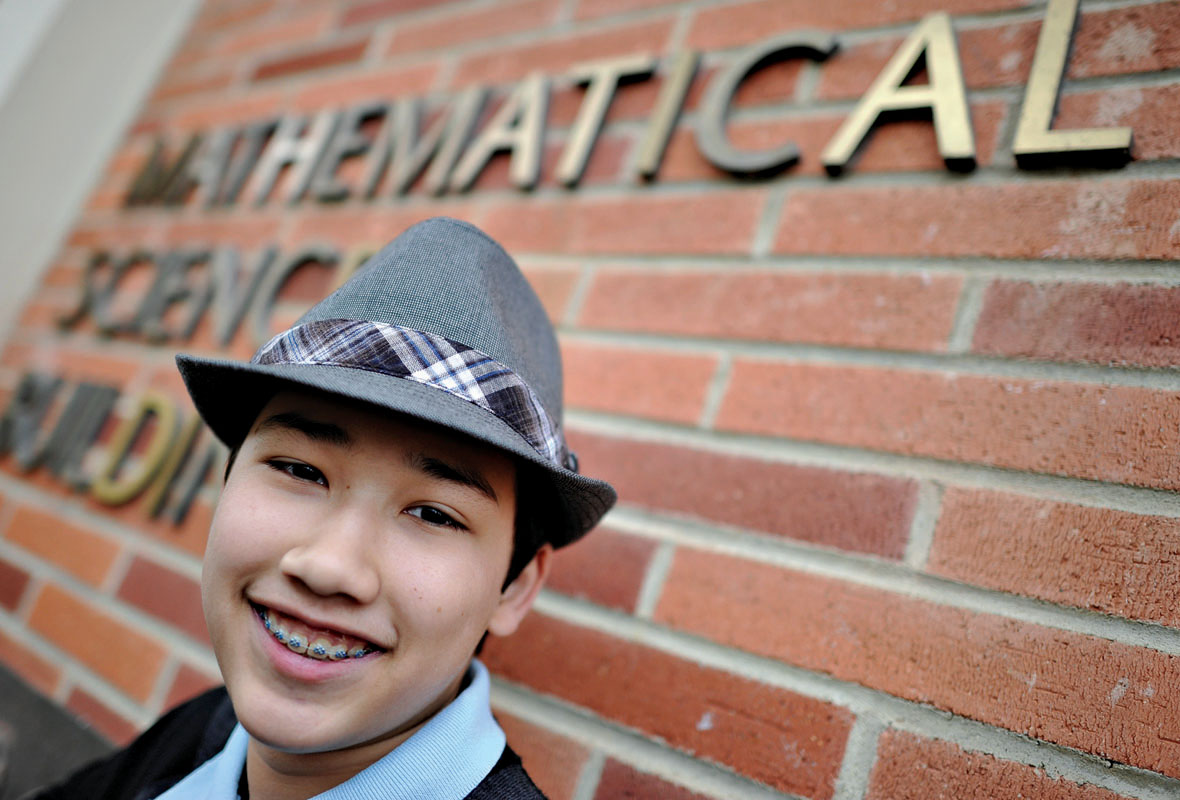
The High Extreme
In one famous project begun in 1921, psychologist Lewis Terman studied more than 1500 California schoolchildren with IQ scores over 135. These high-scoring children (later called the “Termites”) were healthy, well-adjusted, and unusually successful academically (Koenen et al., 2009; Lubinski, 2009a; Stanley, 1997). When restudied over the next seven decades, most had attained high levels of education (Austin et al., 2002; Holahan & Sears, 1995). Many were doctors, lawyers, professors, scientists, and writers.
A more recent study focuses on young people who aced the math SAT® at age 13—by scoring in the top quarter of 1 percent of their age group. At age 33, these math aces were twice as likely to have patents as were those who had scored in the bottom quarter of the top 1 percent (Wai et al., 2005). Compared with the math stars, 13-year-olds scoring high on verbal aptitude were more likely to have become humanities professors or written a novel (Park et al., 2007). About 1 percent of Americans earn doctorates. But among those scoring in the top 1 in 10,000 on the SAT® at age 12 or 13, more than half have done so (Lubinski, 2009b).
These whiz kids remind me of Jean Piaget, the twentieth century’s most famous developmental psychologist. By age 15, he was already publishing scientific articles on mollusks (Hunt, 1993). Children with extraordinary academic gifts are sometimes more isolated, introverted, and in their own worlds (Winner, 2000). But most thrive.

243
Should we therefore expect that several biologically unrelated children who are adopted into the same family will share similar aptitudes? Seeking to untangle the effects of genes and environment, researchers have compared the intelligence test scores of adopted children with those of their
- biological parents (the providers of their genes).
- adoptive parents (the providers of their home environment).
- adoptive siblings (who share that home environment).
During childhood, adoptive siblings’ test scores correlate modestly. What do you think happens as the years go by and adopted children settle in with their adoptive families? Would you expect the shared-home-environment effect to grow stronger, and the shared-gene effect to shrink?
If you said Yes, I have a surprise for you. Mental similarities between adopted children and their adoptive families lessen with age. By adulthood they drop to roughly zero (McGue et al., 1993). Genetic influences—not environmental ones—become more apparent as we accumulate life experience. Identical twins’ similarities, for example, continue or increase into their eighties (Deary et al., 2009). Similarly, in verbal ability, adopted children become more like their biological parents as the years go by (FIGURE 8.12). Who would have guessed?

To read more about genetic influences on intelligence, see Close-Up: What Is Heritability?.
How Does Environment Influence Intelligence?

We have seen that biology and experience intertwine. Nowhere is this more apparent than in the most hopeless human environments. Severe deprivation leaves footprints on the brain, as J. McVicker Hunt (1982) observed in one Iranian orphanage. The typical child Hunt observed there could not sit up unassisted at age 2 or walk at age 4. The little care the infants received was not in response to their crying, cooing, or other behaviors, so the children developed little sense of personal control over their environment. They were instead becoming passive “glum lumps.” Extreme deprivation was crushing native intelligence—a finding confirmed by other studies of children raised in poorly run orphanages in Romania and elsewhere (Nelson et al., 2009; van IJzendoorn et al., 2008).
244
Mindful of the effect of early experiences and early intervention, Hunt began a training program for caregivers, teaching them to play language-fostering games with 11 infants. They learned to imitate the babies’ babbling. They engaged them in vocal follow-the-leader. And, finally, they taught the infants sounds from the Persian language. The results were dramatic. By 22 months of age, the infants could name more than 50 objects and body parts. They so charmed visitors that most were adopted—an impressive new success rate for the orphanage.
C L O S E - U P
What Is Heritability?
Heritability of intelligence is the portion of the variation among people’s test scores that we can assign to genetic factors. This genetically influenced portion is often estimated to be 50 percent or more (Johnson et al., 2009). Does this mean your genes are responsible for 50 percent of your intelligence and your environment is responsible for the rest? No. It means we credit heredity with 50 percent of the variation in intelligence among people being studied. This point is so often misunderstood that I repeat: Heritability never applies to an individual, only to why people in a group differ from one another.
Heredity’s influence on the range of test scores varies from study to study. Where environments vary widely, as they do among children of less-educated parents, environmental differences are better predictors of intelligence scores (Rowe et al., 1999). To see why, consider humorist Mark Twain’s fantasy of raising boys in barrels until age 12, feeding them through a hole. Let’s take his joke a step further and say we’ll give all those boys an intelligence test at age 12. Since their environments were all equal, any differences in their test scores could only be due to their heredity. In this “study,” heritability would be 100 percent. But what if a mad scientist cloned 100 boys and raised them in drastically different environments (some in barrels and others in mansions)? In this case, their heredity would be equal, so any test-score differences could only be due to their environment. The environmental effect would be 100 percent, and heritability would be zero.
In the real world, your genes and your environment work together. Suppose that (thanks to your genes) you are just slightly taller and quicker than others (Flynn, 2003, 2007). If you try out for a basketball team, you will more likely be picked. Once on the team, you will probably play more often than others (getting more practice and experience) and you will receive more coaching. The same would be true for your separated identical twin—who might, not just for genetic reasons, also become a basketball star. Our genes shape the experiences that shape us. (Recall from Chapter 3 that epigenetics is the field that studies this nature–nurture meeting place.) If you have a natural aptitude for academics, you will more likely stay in school, read books, and ask questions—all of which will increase your brain power. In these gene-environment interactions, small genetic advantages can trigger social experiences that multiply our original skills.
RETRIEVE + REMEMBER
Question 8.15
A check on your understanding of heritability: If environments become more equal, the heritability of intelligence would
|
a. (Heritability—variation explained by genetic influences—will increase as environmental variation decreases.)
245
So, malnutrition, sensory deprivation, and social isolation can slow normal brain development. Is the reverse also true? Will an “enriched” environment give normal children a superior intellect? Most experts are doubtful (Bruer, 1999). In experiments, infants’ word learning has been unaffected by exposure to educational DVDs (DeLoache et al., 2010; Reichert et al., 2010). All babies should have normal exposure to sights, sounds, and speech. Beyond that, developmental psychologist Sandra Scarr’s (1984) verdict is still widely shared: “Parents who are very concerned about providing special educational lessons for their babies are wasting their time.” There is no environmental recipe for fast-forwarding a normal infant into a genius.
Intelligence Across the Life Span: Stability or Change?
8-18 How stable are intelligence scores across people’s lives, and how do psychologists study this question?
Intelligence endures. By age 4, children’s intelligence test scores begin to predict their adolescent and adult scores. By late adolescence, intelligence and other aptitude scores display remarkable stability. How do we know this?
- Cross-sectional studies compare people of different ages with one another.
- Longitudinal studies restudy and retest the same people over a long period of time.
Scottish researcher Ian Deary and his colleagues (2004, 2009) set a record for a long-term study, and their story is one of psychology’s great tales. On June 1, 1932, Scotland did what no other nation has done before or since. To identify working-class children who would benefit from further education, the government gave every child born in Scotland in 1921 an intelligence test—87,498 eleven-year-olds in all.
On June 1, 1997, sixty-five years later to the day, Patricia Whalley, the wife of Deary’s co-worker, Lawrence Whalley, discovered the test results on dusty store-room shelves at the Scottish Council for Research in Education, not far from Deary’s Edinburgh University office. “This will change our lives,” Deary replied when Whalley told him the news. And so it has, with dozens of studies of the stability and the predictive capacity of these early test results.
For example, 542 survivors from the 1932 test group were retested at age 80 (Deary et al., 2004). After nearly 70 years of varied life experiences, the test-takers’ two sets of scores showed a striking correlation of +.66. When 207 survivors were again retested at age 87, the correlation with their age 11 scores was +.51 (FIGURE 8.13). A later study that followed Scots born in 1936 from ages 11 to 70 confirmed the remarkable stability of intelligence, independent of life circumstance (Johnson et al., 2010).
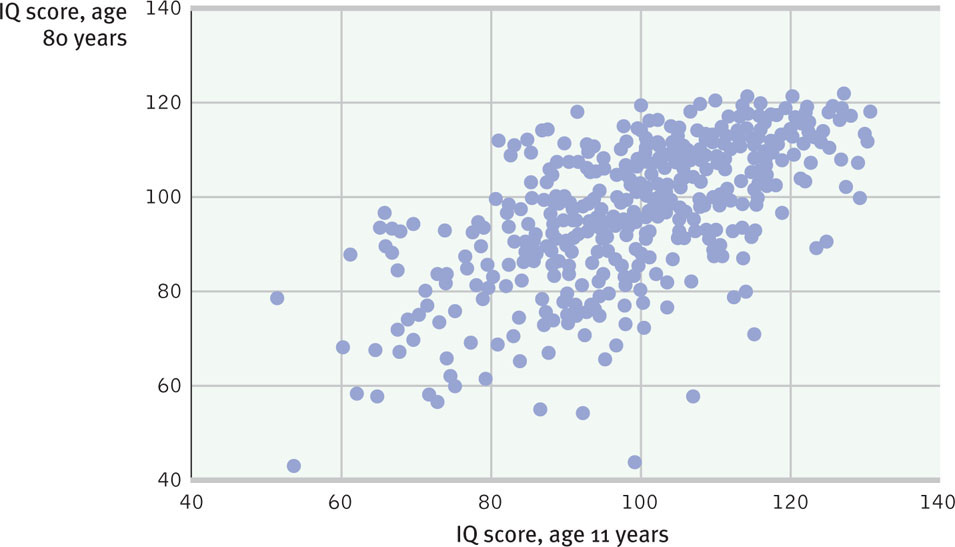
Another interesting finding was that high-scoring 11-year-olds outlived others in the study. As 77-year-olds, they were more likely to be living independently and less likely to have Alzheimer’s disease (Starr et al., 2000; Whalley et al., 2000). World War II had prematurely ended the lives of many of the male test-takers, but female scores showed a striking difference. Seventy percent who had scored in the top quarter as 11-year-olds were still alive at age 76. Only 45 percent of those scoring in the lowest quarter were still alive. Follow-up studies with other large samples from different groups have confirmed this finding: More intelligent children and adults live healthier and longer lives (Calvin et al., 2011; Deary et al., 2010; Snowdon et al., 1996).
Pause a moment: Have you any ideas why more intelligent people might live longer? Deary (2008) offered four possible explanations:
246
- Intelligence gives people better access to more education, better jobs, and a healthier environment.
- Intelligence encourages healthy living: less smoking, better diet, more exercise.
- Prenatal events or early childhood illnesses could influence both intelligence and health.
- A “well-wired body,” as evidenced by fast reaction speeds, may foster both intelligence and longer life.
So, intelligence is strikingly stable. And high intelligence is a predictor of health and long life. Yet, with age, our knowledge and our mental agility change, as we see next.
Crystallized and Fluid Intelligence
8-19 What are crystallized and fluid intelligence, and how does aging affect them?
What happens to our intellectual powers as we age? The answer to that question depends on the task and the type of ability it represents (Cattell, 1963; Horn, 1982; Salthouse, 2004, 2009).
- Crystallized intelligence—our accumulated knowledge, as reflected in vocabulary and word-power tests—increases as we age, into middle age.
- Fluid intelligence—our ability to reason speedily and abstractly, as when solving unfamiliar logic problems—decreases as we age (Park et al., 2002). It declines gradually until about age 75, and then, especially after age 85, decreases more rapidly.
With age we lose and we win. We lose recall memory and processing speed, but we gain vocabulary knowledge (FIGURE 8.14). Our decisions also become less distorted by negative emotions such as anxiety, depression, or anger (Blanchard-Fields, 2007; Carstensen & Mikels, 2005).

These life-span differences in mental abilities help explain why older adults are less likely to embrace new technologies (Charness & Boot, 2009). In 2010, only 31 percent of Americans ages 65 and older had broadband Internet at home, compared with 80 percent of adults under 30 (Pew, 2010).
The age-related differences also help explain some curious findings about creativity. Mathematicians and scientists, who draw on their fluid intelligence, produce much of their most creative work during their late twenties or early thirties. Prose authors, historians, and philosophers, who depend more on crystallized intelligence, tend to hit their peak in their forties, fifties, and beyond (Simonton, 1988, 1990).
Group Differences in Intelligence Test Scores
If there were no group differences in aptitude scores, psychologists could politely debate hereditary and environmental influences in their ivory towers. But there are group differences. What are they? And what do they mean?
Gender Similarities and Differences
8-20 How and why do the genders differ in mental ability scores?
In science, as in everyday life, differences, not similarities, excite interest. Compared with the many ways men and women are physically alike, our differences are fairly minor. In the 1932 testing of all Scottish 11-year-olds, for example, girls’ average intelligence score was 100.6 and boys’ was 100.5 (Deary et al., 2003, 2009). So far as g is concerned, boys and girls, men and women, are the same species.
Yet, most people find differences more newsworthy. Girls outpace boys in spelling, verbal fluency, and locating objects. They are better emotion detectors and are more sensitive to touch, taste, and color (Halpern et al., 2007). In math computation and overall math performance, girls and boys hardly differ (Else-Quest et al., 2010; Hyde & Mertz, 2009; Lindberg et al., 2010). But in tests of spatial ability and complex math problems, boys outperform girls.
247

Males’ mental ability scores also vary more than females’. Worldwide, boys outnumber girls at both the low extreme and the high extreme (Johnson et al., 2008; Machin & Pekkarinen, 2008; Strand et al., 2006). Boys, for example, are more often found in special education classes. And among American 12- to 14-year-olds with extremely high SAT® math scores (700 or above), boys outnumber girls 4 to 1 (Wai et al., 2010).
The most reliable male edge appears in spatial ability tests like the one shown in FIGURE 8.15. To solve the problem, you must quickly rotate three-dimensional objects in your mind (Collins & Kimura, 1997; Halpern, 2000). Today, such skills help when fitting suitcases into a car trunk, playing chess, or doing certain types of geometry problems. Evolutionary psychologists believe these same skills would have had survival value for our ancestral fathers, helping them to track prey and make their way home (Geary, 1995, 1996; Halpern et al., 2007). The survival of our ancestral mothers may have benefited more from a keen memory for the location of edible plants. That legacy lives today in women’s superior memory for objects and their location.

ANSWERS: The first and fourth responses.
But remember that our experiences form pathways in the brain. Playing action video games boosts spatial abilities (Feng et al., 2007). And who spends more time playing video or computer games? Among entering American collegians, six times as many men (23 percent) as women (4 percent) report playing these games six or more hours a week (Pryor et al., 2010). Experience matters.
Social expectations and opportunities also matter. Gender-equal cultures, such as Sweden and Iceland, exhibit little of the gender math gap found in gender-unequal cultures, such as Turkey and Korea (Guiso et al., 2008). In Russia, Asia, and even the Middle East—where science and engineering are not considered masculine subjects—15-year-old girls slightly outperformed boys on an international science exam (Fairfield, 2012).
Racial and Ethnic Similarities and Differences
8-21 How and why do racial and ethnic groups differ in mental ability scores?
Fueling the group-differences debate are two other disturbing but agreed-upon facts:
- Racial and ethnic groups differ in their average intelligence test scores.
- High-scoring people (and groups) are more likely to achieve high levels of education and income.
There are many group differences in average intelligence test scores. In New Zealand, people of European descent outscore people of native Maori decent. In Israel, Jews outscore Arabs. In Japan, most Japanese outscore most Burakumin, a stigmatized minority group. And in the United States, White Americans have outscored Black Americans. This difference has been some-what smaller in recent years, especially among children (Dickens & Flynn, 2006; Nisbett, 2009).
248
One more agreed-upon fact is that group differences provide little basis for judging individuals. Worldwide, women outlive men by four years, but knowing that you are male or female won’t tell us much about how long you will live.
We have seen that heredity contributes to individual differences in intelligence. But group differences in a heritable trait may be entirely environmental, as in our earlier boys-in-barrels versus boys-in-mansions example. Consider one of nature’s experiments: Allow some children to grow up hearing their culture’s dominant language, while others, born deaf, do not. Then give both groups an intelligence test rooted in the dominant language. The result? No surprise. Those with expertise in the dominant language will score higher than those who were born deaf (Braden, 1994; Steele, 1990; Zeidner, 1990). Within each group, the differences between individuals are mainly a reflection of genetic differences. Between the two groups, the difference is mainly environmental (FIGURE 8.16).

Might racial and ethnic gaps be similarly environmental? Consider:
Genetics research reveals that under the skin, the races are remarkably alike. The average genetic difference between two Icelandic villagers or between two Kenyans greatly exceeds the group difference between Icelanders and Kenyans (Cavalli-Sforza et al., 1994; Rosenberg et al., 2002). Moreover, looks can deceive. Light-skinned Europeans and dark-skinned Africans are genetically closer than are dark-skinned Africans and dark-skinned Aboriginal Australians.

Race is not a neatly defined biological category. Many social scientists think race is no longer a meaningful term. They view race primarily as a social category without well-defined physical boundaries. Each racial group, they point out, blends seamlessly into its geographical neighbors (Helms et al., 2005; Smedley & Smedley, 2005). Moreover, with increasingly mixed ancestries, fewer and fewer people fit neatly into any one category, and more and more identify themselves as multiracial (Pauker et al., 2009).
Within the same population, there are generation-to-generation differences in test scores. Test scores of today’s better-fed, better-educated, and more test-prepared population exceed the scores of the 1930s population (Flynn, 2007). The two generations differ by a greater margin than the intelligence test score of the average White today exceeds that of the average Black. The average intelligence test performance of today’s sub-Saharan Africans is the same as British adults in 1948, with the possibility of more gains to come, given improved nutrition, economic development, and education (Wicherts et al., 2010). No one credits the generation-to-generation differences to genetics.
249
Given the same information, Blacks and Whites show similar information-processing skills. Research findings indicate that cultural differences in access to information may account for racial differences in intelligence test performance (Fagan & Holland, 2007).
Schools and culture matter. A country’s rich-poor wealth gap correlates with its rich-poor intelligence test score gap (Nisbett, 2009). Moreover, educational policies—such as kindergarten attendance, school discipline, and instructional time per year—predict national differences in intelligence and knowledge tests (Rindermann & Ceci, 2009). An example: Asian students have outperformed North American students on math achievement and aptitude tests. This difference may reflect culture more than inborn abilities (Fagan & Holland, 2007). Compared with Americans, Asian students attend school 30 percent more days per year, and they spend much more time studying math in and out of school (Geary et al., 1996; Larson & Verma, 1999; Stevenson, 1992).
In different eras, different ethnic groups have experienced golden ages—periods of remarkable achievement. Twenty-five hundred years ago, it was the Greeks and the Egyptians, then the Romans. In the eighth and ninth centuries, genius seemed to reside in the Arab world. Five hundred years ago, the Aztecs and North Europeans took the lead. Today, we marvel at Asians’ technological genius and Jews’ cultural success. Cultures rise and fall over centuries. Genes do not. That fact makes it difficult to believe in the natural genetic superiority of any racial or ethnic group. 
RETRIEVE + REMEMBER
Question 8.16
The heritability of intelligence scores will be greater in a society marked by equal opportunity than in a society of poor peasants and wealthy aristocrats. Why?
Perfect environmental equality would create 100 percent heritability, because genes alone would account for any remaining human differences.
Are Test Questions Biased?
8-22 Are intelligence tests biased and discriminatory?
Knowing there are group differences in intelligence test scores leads us to wonder whether those differences are built into the tests. Are intelligence tests biased? The answer depends on how we define bias.
One way a test can be biased is if scores are influenced by a person’s cultural experience. This in fact happened to Eastern European immigrants in the early 1900s. Lacking the experience to answer questions about their new culture, many were classified as feeble-minded.
The scientific meaning of bias hinges on a test’s validity. A valid intelligence test should predict future behavior for all groups of test-takers, not just for some. For example, if the SAT® accurately predicted the college achievement of women but not that of men, then the test would be biased. Almost all psychologists agree that in this scientific sense, the major U.S. aptitude tests are not biased (Hunt & Carlson, 2007; Neisser et al., 1996; Wigdor & Garner, 1982). Their predictive validity is roughly the same for women and men, for various races, and for rich and poor. If an intelligence test score of 95 predicts slightly below-average grades, that rough prediction usually applies equally to both genders and all ethnic and economic groups. 
RETRIEVE + REMEMBER
Question 8.17
What is the difference between a test that is biased culturally and a test that is biased in terms of its validity?
A test may be culturally biased if higher scores are achieved by those with certain cultural experiences. That same test may not be biased in terms of validity if it predicts what it is supposed to predict. For example, the SAT® may be culturally biased in favor of those with experience in the U.S. school system, but it does still accurately predict U.S. college success.
STEREOTYPE THREAT Our expectations and attitudes can influence our perceptions and behaviors. They can also influence our performance on intelligence tests. If you worry that your group or “type” often doesn’t do well on a certain kind of test, your self-doubts and self-monitoring may hijack your working memory and hurt your performance (Schmader, 2010). This self-confirming concern that you will be evaluated based on a negative viewpoint is called stereotype threat, and it may impair your attention and learning (Inzlicht & Kang, 2010; Rydell et al., 2010).
“Math class is tough!”
“Teen talk” talking Barbie doll (introduced February 1992, recalled October 1992)
In one study, equally capable men and women took a difficult math test. The women did not do as well as the men—except when they had been led to expect that women usually do as well as men on the test (Spencer et al., 1997). Without this helpful hint, women apparently expected they would not do well. This feeling then led them to live down to their own expectations. Stereotype threat appeared again when Black students were reminded of their race just before taking verbal aptitude tests and performed worse (Steele et al., 2002). Negative stereotypes may undermine people’s academic potential (Nguyen & Ryan, 2008; Walton & Spencer, 2009).
250
Stereotype threat helps explain why Blacks have scored higher when tested by Blacks than when tested by Whites (Danso & Esses, 2001; Inzlicht & Ben-Zeev, 2000). It gives us insight into why women have scored higher on math tests with no male test-takers present, and why women’s internet chess play drops sharply when they think they are playing a male opponent (Maass et al., 2008). It also explains “the Obama effect”—the finding that African-American adults performed better if they took a verbal aptitude test immediately after watching then-candidate Barack Obama’s stereotype-defying nomination-acceptance speech, or just after his 2008 presidential victory (Marx et al., 2009).
Could remedial “minority support” programs function as a stereotype that can erode performance? Some researchers believe they can, by telling students they probably won’t succeed. College programs that challenge minority students to believe in their potential, or to focus on the idea that intelligence is not fixed, have had good results. Students’ grades were markedly higher, and their dropout rates lower (Wilson, 2006).
Believing that intelligence is changeable, rather than biologically fixed, can foster a growth mind-set (Dweck, 2012). Collegians with a growth mind-set tend to flourish happily (Howell, 2009). Fostering a growth mind-set means teaching young teens that the brain is like a muscle that grows stronger with use as neuron connections grow. Recall the 10-year rule discussed earlier. Superior achievements in fields from sports to science to music arise from disciplined effort and sustained practice (Ericsson et al., 2007). To reach your potential, the formula is simple: Believe in your ability to learn and apply yourself with sustained effort.
What time is it now? Earlier in this chapter, did you underestimate or overestimate how quickly you would finish the chapter?
Perhaps, then, our goals for tests of mental abilities should be threefold.
- We should realize the benefits Alfred Binet foresaw—to enable schools to recognize who might profit most from early intervention.
- We must remain alert to Binet’s fear that intelligence test scores may be misinterpreted as literal measures of a person’s worth and potential.
- We must remember that the competence that general intelligence tests sample is important; without such tests, those who decide on jobs and admissions would rely more on other considerations, such as personal opinion. But these tests reflect only one aspect of personal competence. Our practical intelligence and emotional intelligence matter, too, as do other forms of creativity, talent, and character.
The point to remember: There are many ways of being successful: Our differences are variations of human adaptability. Life’s great achievements result not only from abilities but also from motivation. Competence + Diligence = Accomplishment.
